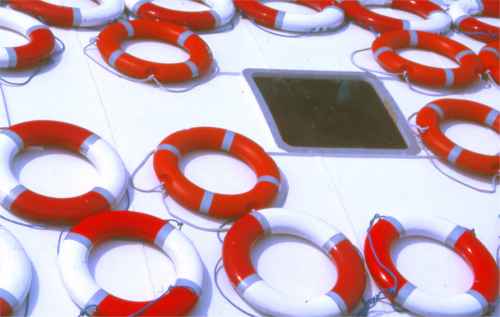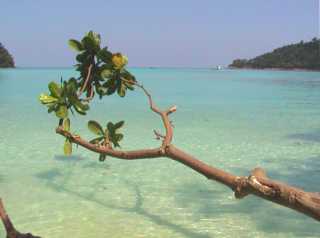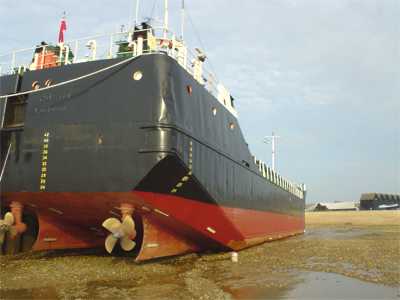This picture is courtesy of Orsolya Hetey.
 |
First Aid courses
A lot of working people do a First Aid course every three years as a requirement of their job. Industrial courses usually last one to two days, assume that an ambulance will arrive within 30 minutes, and concentrate on urban hazards such as slips, trips, asthma attacks and electrocution.
There are also longer courses for outdoor professionals such as kayak coaches who may have to deal with hazards like hypothermia and drowning, and who may have to keep a casualty alive in a tent for several days. Much more fun. In Britain, there are various courses lasting 16 hours or longer which satisfy the requirements of the British Canoe Union and the Mountain Leader training boards. See www.mltuk.org. These include the standard US/Canadian 40-hour Wilderness Advanced First Aid course (WAFA) and 80-hour Wilderness First Responder (WFR) courses.
Small First Aid kit
It is possible to make out a good case for carrying no more than a roll of 50 mm (2") wide waterproof duct tape. With that, you can temporarily repair most damage to people, clothing or equipment.
This minimum First Aid kit will fit easily into a small dry-bag which also contains a minimum repair kit and your money and car keys:
• A roll of 50 cm wide waterproof sticky tape and
• A NATO military "shell dressing". That is a sterile absorbent pad in a tough waterproof pouch the size of a packet of cigarettes, with tapes to attach it to the casualty. Even if a shell dressing has never left the store cupboard, it has an expiry date. You can buy the time-expired ones cheaply from military surplus shops. See Kayarchy Shopping. You may be able to buy the civilian equivalent from a good pharmacy or a specialist medical supplier.
Big First Aid kit
For an advanced expedition where injury is more likely and professional help is further away, it is good if at least some of the group have done an advanced First Aid course within the eighteen months.
Your editor's own kit is a small waterproof box containing the following, each of which is sealed into a Zip-Lock plastic bag before the box itself is sealed with waterproof tape:
• Roll of 50 cm wide waterproof sticky tape.
• Shell dressing. See above.
• Two wound dressings, 10 cm x 10 cm, absorbent cotton with perforated film on one side. For example, Melolin.
• Two 50 mm cotton crepe bandages.
• Three large (50 mm) safety pins.
• Pack of ten 10 cm x 0.6 cm self-adhesive strips such as Steri-Strips. Used to close wounds which would otherwise need sutures.
• Pair of thin, disposable latex gloves. The main purpose is so that the First Aider does not contaminate the casualty's wound.
• Small pair of sharp scissors. Not the useless little scissors supplied in commercial First Aid kits.
• Surgical tape. A non-waterproof permeable non-woven synthetic adhesive tape such as Micropore or Fortuna is good for attaching wound dressings to dry skin. It also makes an excellent "on the water" dressing for the blisters on the thumbs of an inexperienced kayaker.
• Selection of waterproof sticking plasters for small cuts.
• Micro bottle of antiseptic solution for disinfecting cuts.
• Short, strong tweezers with sharp points that actually meet. We love the Miracle Point "Splinter Expert" but can you buy it in Europe at present?
• Small nail clippers.
• For cracked skin on hands, a good cream such as Neutrogena.
• Antiseptic cream such as Savlon.
• Painkiller such as ibuprofen.
• For trips where you might encounter a venomous snake, scorpion or centipede, a venom extractor suction kit like the Aspivenin or the Sawyer Extractor, and a compression bandage to slow down the rate at which venom enters the rest of the body.
Before foreign travel
 No doubt you will get the usual vaccinations recommended for travel to your destination. Note that in areas where hepatitis A is widespread, it has been found in both fresh water and sea water.
No doubt you will get the usual vaccinations recommended for travel to your destination. Note that in areas where hepatitis A is widespread, it has been found in both fresh water and sea water.
Is there is a malaria risk in your destination country, or any country where your aircraft will set down on the way? You might be surprised where you can catch malaria. Europe is generally free of the disease but it was widespread in Greece until the 1930s and there was an epidemic during the German occupation in 1943. It is still present in some parts of Turkey.
There is a malaria risk in parts of the Caribbean, Mexico and the Middle East. It is present in most of South America, Africa and SE Asia. You can obtain anti-malarial medication from a doctor before travelling, and take precautions to reduce the number of mosquito bites. See Insect Equipment.
Will you be able to drink un-filtered water from streams without boiling it first? In tropical countries, is it safe to use local tap water or bottled water for drinking or cleaning your teeth? Is it safe to eat salads washed in tap water? See Water.
 Will there be snakes, scorpions or toxic centipedes? If so, it is worth carrying a venom extractor suction kit and a compression bandage.
Will there be snakes, scorpions or toxic centipedes? If so, it is worth carrying a venom extractor suction kit and a compression bandage.
Also, find out how to deal with any bites and stings you may encounter, including those of jellyfish. Some venom yields to the immediate application of water as hot as your skin can bear, and/or a mild acid such as lemon juice or vinegar, plus prompt application of a compression bandage. Some requires the appropriate anti-venom serum.
Your editor was once bitten by a tropical centipede which shot up his trousers during dinner and punched two large, bloody holes in his leg. This is quite painful and normally causes severe swelling for several days. A team from Bristol Zoo happened to be sitting at the next table with a venom extractor kit, and about a minute later a local man emerged from the kitchen with a bowl of hot water, a cloth and half a lemon. Thanks to them, he got off lightly!
If you are lucky enough to live in a country where antibiotics and other pharmacy supplies are always of good quality, bear in mind that in most of Africa and parts of Asia they are often counterfeit and will have little or no effect. You can obtain some medication before you leave, without a prescription. For example, in Britain you can get antibiotic eye drops and "morning after" contraceptive tablets without a prescription - if you can persuade the pharmacist you need them. If you know a friendly doctor who will give you a prescription, get a couple of courses of oral antibiotics to take with you.
Legal requirements for sea kayaking
In many countries, sea kayakers are required to comply with regulations intended to prevent accidents, ensure free passage for shipping, protect fisheries or the natural environment, protect children from abuse, prevent untaxed imports of vehicles or kayaks, or exclude competition from foreign manufacturers and instructors.
We welcome accurate information about legal requirements, or their absence - please write in! See Get In Touch. If you can, please cite an official website where readers can go to check the latest position. Kayarchy is a free website and accepts no responsibility for incorrect information.
International law
Every seafarer is required to comply with the International Regulations For Preventing Collision At Sea.
For a sea kayaker, the COLREGS can be summarised in a dozen words: Stay out of everybody else's way, and carry a powerful torch at night. See Getting Run Over and Night Navigation.
United Kingdom law
In the UK there seem to be no legal requirements for the safety of individual sea kayakers. You don't need a qualification or any particular safety equipment, other than an operator's licence if you choose to carry a VHF radio.
However organisers of commercial trips for under 18s are required to have a license which does in practice mean that you must have certain training and equipment. Those who kayak with other people's children may be required to comply with "child protection" legislation. See Child Safety and Child Protection Law.
Under local legislation, it may be a criminal offence to kayak next to a Royal Navy munitions loading dock or to enter a military firing range. See Exclusion Zones. There are also areas within major commercial and military harbours that you can enter or cross only after obtaining permission using a VHF radio. Danger areas and exclusion zones are marked on up to date Ordnance Survey maps and Admiralty charts, and often indicated at sea by a row of yellow buoys (although yellow buoys may indicate nothing more hazardous than a swimming beach)
Fishing from your kayak in certain rivers and estuaries, and collecting shellfish in certain areas, is a criminal offence.
It is an offence to kill or harass many species of bird and animal. See Protecting The Environment.
Irish law
No doubt the Republic of Ireland has similar rules to those in the United Kingdom concerning military and port exclusion zones, poaching, theft, environmental destruction and child protection.
In addition, it is an offence to go to sea (even on an inflatable toy being towed behind a power boat) without wearing an adequate buoyancy aid.
French law
We don't know whether non-residents are expected to comply with all these rules but most gendarmes, CRS maîtres-nageurs and agents de police will sheer off the moment they realise you may not speak French.
With effect from 15.04.08, under Division 240, a registered kayak may go up to six "milles" from an "abri" if it falls within the definition of "autovideur" (self-bailing). A mille is a nautical mile. See The Nautical Mile. An abri, literally a shelter, is anywhere a kayak may land or anchor in safety. A kayak is considered to be self-bailing if all apertures are effectively sealed with spray deck and hatch covers.
Sea kayaks must be registered seaworthy (homologation) which you can do free at the local Bureau des Affaires Maritimes. They want to see a satisfactory design, satisfactory condition with no leaks, and foam flotation in the ends. A kayak made by a French manufacturer after 2002 will have a CIN plate somewhere inside the cockpit to show that it complies but for older or home-built kayaks you must complete a "déclaration de conformité d’un navire de plaisance" which you can download from various places such as here. Sea kayakers going more than 300 metres offshore must get themselves registered. On producing an identity card, evidence of address, telephone number and a "déclaration de conformité" the kayaker will be issued with a "carte de circulation" and is in theory required to carry it when on the water, but is not required to display a sticker.
To go the maximum six miles a kayaker is required to have:
• Buoyancy aid
• Personal light. See Personal Strobe Lights.
• Towing arrangement, which apparently means a snap-link and a rope at least as long as the kayak. See Tow-Belt and Towing Cleat.
• Three red hand flares
• Signal mirror / heliograph
• Compass
• Chart
• Whistle
A kayaker with less equipment may still go up to two nautical miles from an abri in a registered kayak, but is always required to have:
• Buoyancy aid
• Personal light
• Towing arrangement
• Built-in or portable pump unless the kayak is self-bailing as defined. A portable pump must be attached to the kayak with a lanyard.
Plasmor Kayaks say you are also required to have a paddle float, a waterproof torch and a foghorn but we haven't seen that said anywhere else. To check you have the latest information, go to www.ckmer.org
Professional guides and instructors operating in France are required to have certain qualifications, whatever the nationality of those participating. And they really mean it. British white water guides are regularly "controlled" about this on the river bank, and British ski guides have been arrested on the piste by uniformed gendarmes. Some British kayak instructing qualifications are accepted in France.
US law
Requirements vary from state to state. Sea kayakers are usually required to carry a USCG-approved PFD (buoyancy aid or lifejacket), a whistle or foghorn, and a white light visible from one mile away if out between sundown and sunrise. Flares or a strobe light may be required. In some states it is compulsory for the PFD to be worn, not just carried, if the kayaker is under a certain age or is out in the winter months.
Canadian law
Sea kayakers are required to carry a PFD, a 15-metre throwline, a bailer or hand pump, a whistle or foghorn, and a white light if out between sundown and sunrise or in conditions of reduced visibility. If you carry a VHF radio you need an operator's certificate. Source: Transport Canada Sea Kayaking Safety Guide.
Other countries
Rumour has it that it is a criminal offence in Greece to get in the way of a ferry, or to set off an air-sea rescue by letting a kayak float away on the rising tide; and that where the offender was using a rented kayak, the person who rented it to him may also be convicted and fined.
Of course rumour isn't really good enough, so please Get In Touch with accurate information. We will be happy to list it here.

| Go to next page for: • Contents of Sea & Weather chapter |